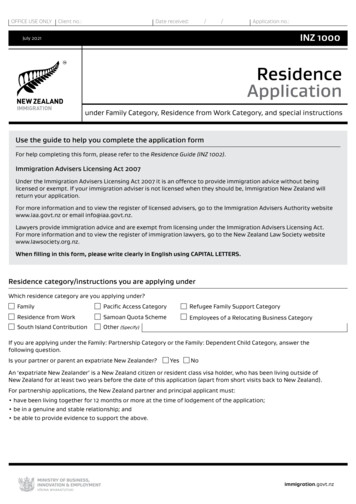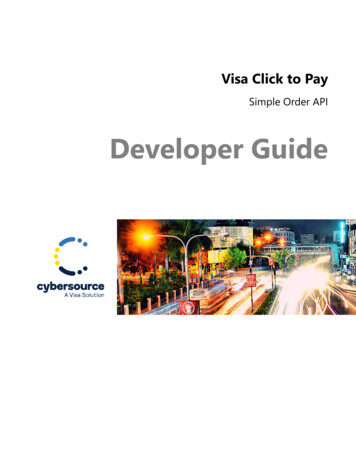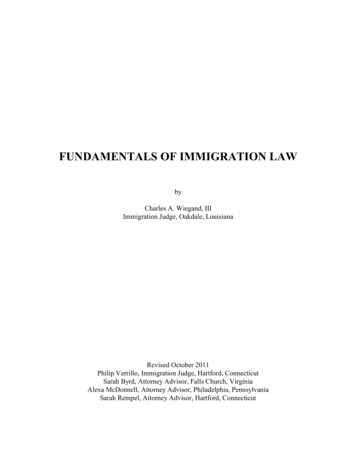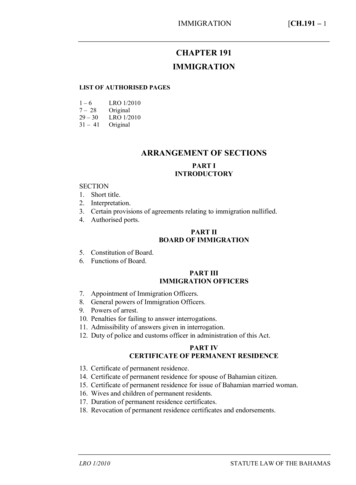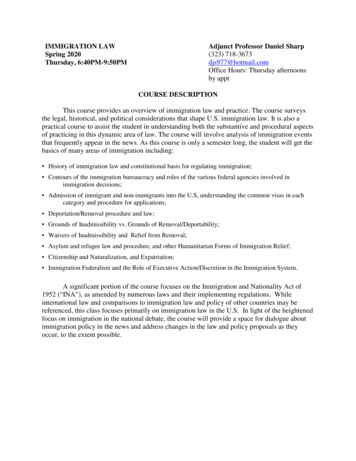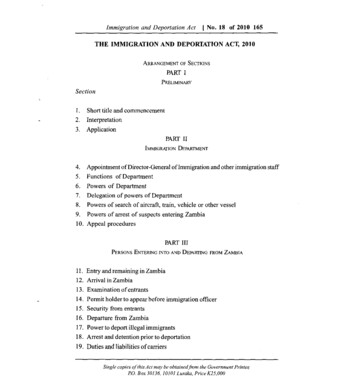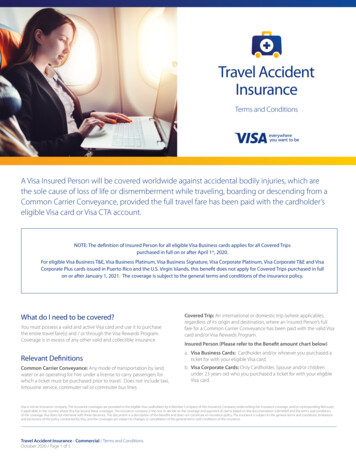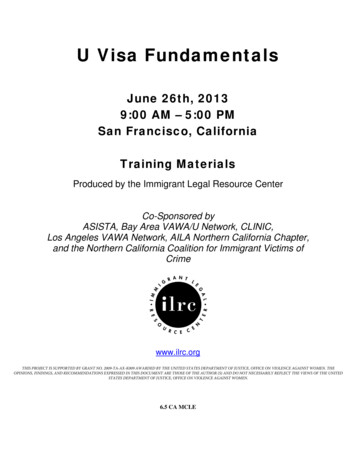
Transcription
U Visa FundamentalsJune 26th, 20139:00 AM – 5:00 PMSan Francisco, CaliforniaTraining MaterialsProduced by the Immigrant Legal Resource CenterCo-Sponsored byASISTA, Bay Area VAWA/U Network, CLINIC,Los Angeles VAWA Network, AILA Northern California Chapter,and the Northern California Coalition for Immigrant Victims ofCrimewww.ilrc.orgTHIS PROJECT IS SUPPORTED BY GRANT NO. 2009-TA-AX-K009 AWARDED BY THE UNITED STATES DEPARTMENT OF JUSTICE, OFFICE ON VIOLENCE AGAINST WOMEN. THEOPINIONS, FINDINGS, AND RECOMMENDATIONS EXPRESSED IN THIS DOCUMENT ARE THOSE OF THE AUTHOR (S) AND DO NOT NECESSARILY REFLECT THE VIEWS OF THE UNITEDSTATES DEPARTMENT OF JUSTICE, OFFICE ON VIOLENCE AGAINST WOMEN.6.5 CA MCLE
U Visa FundamentalsJune 26, 2013, 9:00 am – 5:00 pmSan Francisco, CaliforniaSponsored by: Immigrant Legal Resource Center (ILRC), ASISTA, Bay Area VAWA/U Network, CLINIC,Los Angeles VAWA Network, AILA Northern California Chapter,and the Northern California Coalition for Immigrant Victims of CrimeThis course will provide a comprehensive overview of the entire U nonimmigrant and adjustment of statusprocess, including strategies to get law enforcement agencies to sign the certification of helpfulness. It isintended for those who are new to U visas, including those who are new to legal advocacy and/or new tothe practice of immigration law, those with little or no prior knowledge of immigration law, and those withbasic familiarity with immigration law but no prior experience working on U visas specifically.Agenda9:00-9:30amIntroductions and Overview of Training (Sonia)9:30-11:00amOverview of U Nonimmigrant Status (Susan, Monica, Sarah, Debbie)11:00-11:15amBreak11:15-12:00pmOverview of Inadmissibility Issues and Waivers (Sarah, Debbie)12:00-1:00pmLunch1:00-1:45pmWorking with Law Enforcement (Nancy, Susan)1:45-2:30pmU Nonimmigrant Status Application Process and Practice Pointers (Susan, Cecilia)2:30-3:30pmOverview of U Adjustment of Status (Susan, Nancy)3:30-3:45pmBreak3:45-4:30pmOverview of Consular Processing (Cynthia, Monica)4:30-5:00pmRemaining Questions6.5 CA MCLE
Speaker Bios:Cecelia Friedman Levin, Staff Attorney – AsistaPrior to joining ASISTA as a staff attorney in June 2012, Cecelia Friedman Levin worked as asupervising attorney at Women Empowered Against Violence in Washington, DC and as the domesticviolence staff attorney at the National Law Center for Homelessness and Poverty. She has also been animmigration staff attorney at Ayuda, providing direct legal representation to low‐income immigrants inthe Washington, DC area. Prior to law school, she was a Fulbright Research Scholar in Santiago, Chileassessing community responses to domestic violence. Cecelia received her B.A. in International Studiesand Women & Gender studies from American University and her J.D. from American University‐Washington College of Law.Cynthia LucasCynthia Lucas is a private immigration attorney practicing in Los Angeles, California. Ms. Lucas receivedher B.A. from the University of California, Berkeley, and her J.D. from the University of San Francisco,School of Law. Since law school she has been dedicated to practicing immigration law and providinglegal services to underrepresented populations in family‐based immigration matters, U visas, VAWA,Special Immigrant Juvenile petitions, consular processing and waivers. Her past experience includesextensive public interest work as an attorney at ICWC and the Center for Human Rights andConstitutional Law and as an Associate Attorney at Wolfsdorf Immigration Law Group. She has been aspeaker at various conferences and trainings for the Federal Bar Association, AILA and ILRC. She wasselected as a “Rising Star” in the 2010 Rising Star Edition of Southern California Super Lawyers. Ms.Lucas presently serves on the Executive Committee of the American Immigration Lawyers Association(AILA) Southern California Chapter. She can be contacted at cynlucas@gmail.com.Debbie Smith, Training and Legal Support Attorney – CLINICDebbie Smith is an attorney specializing in immigration law who has practiced for more nearly thirtyyears in the non‐profit, private and public sector. She is an attorney at Catholic Legal ImmigrationNetwork (CLINIC) where she conducts trainings in immigration law. Debbie previously was a staffattorney at the U.S. Court of Appeals for the Ninth Circuit in San Francisco, a partner at the immigrationlaw firm Simmons & Ungar, and the national coordinator of the landmark American Baptist Churches("ABC") class action settlement representing more than 300,000 class members.Monica Kane, Staff Attorney – Neighborhood Legal Services of Los Angeles CountyAt NLSLA, Monica provides free legal assistance and representation in immigration matters to low‐income clients, many of whom are survivors of domestic violence and sexual assault. Monica waspreviously with NLSLA from 2002 to 2005. Before rejoining NLSLA in 2009, she worked with asylees and
refugees at Jewish Family and Children's Services in San Francisco and practiced employment‐basedimmigration law with Haight Law Group, PLC, in Los Angeles. Monica holds a J.D. from UCLA School ofLaw.Nancy J. Reyes‐Rubi, Senior Staff Attorney – Legal Aid Foundation of Los Angeles (LAFLA)As a senior staff attorney at LAFLA for the last 11 years, Nancy has assisted hundreds of domesticviolence victims achieve safety through VAWA, U visas, T visas and other available remedies. Sheprovides technical assistance to other agencies across the state. LAFLA’s Immigration and Asian PacificIslander Units have collaborated to engage in cutting–edge legal work in various areas that assistsurvivors of human trafficking, domestic violence, stalking, and sexual assault. Some of this work hasincluded targeted outreach and services to victims of human trafficking (such as forced prostitution) andassertion of asylum claims based on gender‐based persecution (such as rape and domestic violence).She is also very involved with local immigration networks (VAWA and Trafficking) that focus on makingchanges at the local level to help improve procedures for immigration clients, as well as on a nationallevel. Nancy has provided several U visa & VAWA trainings to community‐based organizations,government agencies, universities and large private law firms interested in pro‐bono VAWA cases. Sheis a member of the American Immigration Lawyers Association and the Los Angeles County Bar’sImmigration Section.Sarah Bronstein, Training & Legal Support Attorney – CLINICMs. Bronstein provides training and technical assistance on immigration law to CLINIC members andother community based organizations. Prior to joining CLINIC’s Training and Legal Support section, Ms.Bronstein served as a detention fellow in CLINIC’s Los Angeles office from 2000 – 2002 representingdetained adults and children in removal proceedings. She subsequently ran CLINIC’s San Franciscodetained children’s representation project from 2002 – 2004 and supervised the legal work of theattorneys in CLINIC’s national detention representation project from 2004 – 2007. Ms. Bronstein is agraduate of the Georgetown University Law Center and is member of the California State Bar.Susan Bowyer, Deputy Director – Immigration Center for Women and Children (ICWC)Susan is the author of a number of publications on immigration remedies for survivors of domesticviolence, including those published by the American Immigration Lawyers Association (AILA), theBerkeley Journal of Gender, Law & Justice, and the Immigrant Legal Resource Center (ILRC). She is afrequent trainer on immigration through the VAWA and U Visa and has presented at the AmericanImmigration Lawyers Association National Conference, California and Central Florida Chapters, theAlameda County Law Enforcement Chiefs’ Annual Conference, on regional and national webinars, andbefore the California State Senate and Assembly Human Service Committees. Susan is a 1992 graduateof Stanford Law School, where she was a Public Service Law Fellow.
U Visa Fundamentals MaterialsJune 26, 2013U Status Overview U Status application contents checklistU Status Application ProcessScreening and Analysis U status screening instructions U Status screening questions (Spanish only) How to review a police report to determine U status eligibilityo Copy of annotated police report Inadmissibility analysisGetting Started First appointment checklist U Status Intake Form Model U Status contract Consent to joint representation (for clients with derivatives) (Sp and Eng) Model letter to ICE – do not detain or deport U Status eligible crime victimo Copy of official ICE memo to attach to ICE letter Authorization to release records Client Advisory on helpfulness in open investigations/prosecutions Document gathering checklist Explanation of U Status Process (Sp and Eng) Forms to show clients when explaining U status processDeclaration Preparation Materials Working with Clients on U Visa Declarations Clarifications and Corrections to mistaken police report Physical Abuse questionnaires (Sp and Eng) Questions to assist with DV declaration (Sp and Eng) Memo – showing substantial emotion abuse Cycle of DV chart (Eng and Sp) Questions to assist with Felonious Assault declaration Trauma symptom checklist (Eng and Sp) Declaration outline for DV Declaration outline for Felonious Assault For Declarations in support of inadmissibility waiver: Hardship/Equities worksheet (Sp and Eng)
I‐192 Declaration outlineSupporting Documents Therapist letter instructions and models Instructions for good moral character letters (Sp and Eng)Forms Model G‐28 I‐918 Preparation Materialso I‐918 Form with explanations of questions and terms (Sp and Eng)o I‐918 yes/no questions in Spanish I‐192 instructions and template languageDerivatives Introduction to working with Derivative applicants Derivative’s I‐192 Declaration outlineCompiling Application Birth Certificate Summary Translation template Fee Waiver request template Model U Status cover letter Model U Status cover letter with explanation that robbery is equivalent to felonious assault Case review checklists for Principal and Derivative applicants Model U status applicationWorking with Law Enforcement I‐918 Supplement B instructions for advocates Model I‐918 Supplement B Template Supplement B request cover memo I‐918 Supplement B request for robbery as felonious assault Model 918B request for stalking Model 918B request for bystander victim Model 918B request for battery as false imprisonment Model 918B request for firing into inhabited dwelling as felonious assault Model 918B request for indirect victim Interim Regulations guidance on bystander victims (to attach to request) Model 918B request for fraud in foreign labor contracting Model 918B request for stalking Model I‐918 Supplement B for battery by multiple suspects as felonious assault and falseimprisonment Model I‐918 Supplement B for battery with great bodily injury as felonious assault Model I‐918 Supplement B for bystander victim Model I‐918 Supplement B for false imprisonment Model I‐918 Supplement B for firing into inhabited dwelling Model I‐918 Supplement B for indirect victim Model I‐918 Supplement B for robbery as felonious assault DHS U Visa certification guide Model letter to new law enforcement agency explaining the U visa Model letter requesting law enforcement agency to revisit narrow certification policy Model training slides for law enforcement training
Memo regarding reasons to certify a closed investigation/prosecutionCleveland Police Chief Op‐Ed on U visasFBI Bulletin article on U visasArticle by Gael Strack for prosecutors about U visasInadmissibility Issues and Waivers U visa waiver sample Practice Guide for Representing U Visa Applicants With Criminal Convictions or Criminal History Overcoming Inadmissibility for U Visa Applicants By Gail Pendleton Questionnaire on Waivers of Inadmissibility on Form I‐192U Adjustment of Status U Visa Adjustment Interview Guide Red Flag Checklist for Adjustment Sample I‐485 Cover Letter (cooperation completed at time of original U cert & no new issues) Sample I‐485 Cover Letter (amending I‐192 with inadmissibility issues missed/ not previouslywaived) Sample Fee Waiver Sample Adjustment Declaration Sample Adjustment Declaration Template Sample “Continued Cooperation” LEA Request Sample language for “Continued Cooperation” I‐918, Supplement B Sample Notices: I‐485 receipt, biometrics & I‐485 approval Qualifying Family Member (I‐929) Sample I‐929 Cover Letter‐basic Sample Declaration of I‐929 Petitioner Sample Declaration of I‐929 Qualifying Family Member Sample Adjustment & concurrent I‐929 Cover Letter & Declaration Template I‐929 Receipt notice I‐929 Approval noticeConsular Processing I‐918 Approval Notice I‐918A Approval Notices U‐1 Visa (waivers approved) U‐2 Visa (no waivers) DS‐160 Questions in English DS‐160 Questions in Spanish U‐3 interview letter CIS Memo on T and U Extensions ICWC GoogleDocs invitation
U Visa FundamentalsJune 26th, 2013 2013 ILRC and ASISTA1Seminar Co-Sponsors 2013 ILRC and ASISTA2Immigrant Legal Resource Center 2013 ILRC and ASISTA31
Today’s Speakers Susan Bowyer, Deputy Director, ICWCSarah Bronstein, Training & Legal Support Attorney, CLINICMonica Kane, Staff Attorney, NLSLADebbie Smith, Training & Legal Support Attorney, CLINICNancy Reyes, Legal Aid Foundation of Los AngelesCecilia Friedman Levin, AsistaCynthia Lucas, Private Immigration Attorney 2013 ILRC and ASISTA4Overview of U Nonimmigrant StatusPresented bySusan Bowyer, Deputy Director, ICWCSarah Bronstein, Training & Legal Support Attorney, CLINICMonica Kane, Staff Attorney, NLSLADebbie Smith, Training and Legal Support Attorney, CLINICImmigrant Legal Resource CenterU Visa Purpose Policy and Humanitarian Fix for UnintendedConsequences of Strict Immigration Policies Law Enforcement policy:– Overcome victim fear of detection; and– encourage reporting and other cooperation Humanitarian policy: help domestic violenceand other crime survivors 2013 ILRC and ASISTA62
Compare VAWA, U Nonimmigrant Status VAWAU Visa Abuser is USC or LPRAbuser spouse/parentBattery or Ext. CrueltyApplicant DeclarationNo law enforcementrequirement Derivative child GMC/Admissible Status of Abuser n/aVictim of CrimeSubstantial AbuseApplicant DeclarationEvidence of crime,helpfulness, LEA Cert More derivatives Admissible (easier) 2013 ILRC and ASISTA7Requirements Victim of Designated Crime– Immediate relative of deceased victim Is/Was/Is Likely to be Helpful to Law EnforcementLaw Enforcement must Certify helpfulnessCan’t unreasonably refuse to helpSubstantial “abuse” as result of crimeAdmissible or eligible for waiver 2013 ILRC and ASISTA8Qualifying Crimes RapeTortureTraffickingIncestDomestic violenceSexual assaultAbusive sexual contactProstitutionSexual exploitationFGMWitness tamperingPerjuryObstruction of justiceStalking (VAWA 2013) Being held hostagePeonageInvoluntary servitudeSlave tradeKidnappingAbductionFalse imprisonmentBlackmailManslaughterMurderFelony assaultLabor Contract Fraud (VAWA2013) 2013 ILRC and ASISTA93
Qualifying Crimes Qualifying crime need not be crime that ischarged, as long as qualifying crime isinvestigated as well 2013 ILRC and ASISTA10“Substantially Similar” GA § 16-5-23.1. Battery (a) A person commits offense of batterywhen s/he intentionally causessubstantial physical harm or visiblebodily harm to another.(b) "visible bodily harm" means bodilyharm capable of being perceived by aperson other than the victim and mayinclude, but is not limited to,substantially blackened eyes,substantially swollen lips or other facialor body parts, or substantial bruises tobody parts.(c) person who commits offense ofbattery is guilty of a misdemeanor. GA § 16-5-24. Aggravatedbattery (a) A person commits theoffense of aggravated batterywhen he or she maliciouslycauses bodily harm to another bydepriving him or her of a memberof his or her body, by rendering amember of his or her bodyuseless, or by seriously disfiguringhis or her body or a memberthereof.(b) shall be punished byimprisonment for not less thanone nor more than 20 years. 2013 ILRC and ASISTA11Substantially Similar Video voyeurism charge – what would thatbe “substantially similar” to? 2013 ILRC and ASISTA124
Direct Victim of Crime “Directly and proximately harmed byqualifying criminal activity” May include bystanders “where bystanderssuffers an unusually direct injury as a result ofa qualifying crime” 2013 ILRC and ASISTA13Indirect Victim of CrimeWhere Direct Victim:1. Died as a result of murder or manslaughter;2. OR, is incompetent or incapacitated;3. OR, is under 18 2013 ILRC and ASISTA14Who’s an Indirect Victim?Following may be indirect victims: Spouses Unmarried children under 21 If victim under 21, parents and unmarried siblingsunder 18 Parents of USC victims “may qualify for Ustatus” (CIS, 6/30/09) 2013 ILRC and ASISTA155
Where Must Crime Occur? Basic rule: In the U.S.– Incl reservations, military installations, territoriesand possessions of U.S.– AND violates U.S. law Narrow exception if outside U.S.– must violate a U.S. federal statute that providesfor extraterritorial jurisdiction 2013 ILRC and ASISTA16Helpful to Law Enforcement INA § 101(a)(15)(U)(i)(III); Victim “has been, isbeing, or is likely to be helpful to a gov’t official orauthority in the investigation or prosecution” ofqualifying crime 8 CFR § 214.14(b)(3); victim cannot refuse or fail toprovide reasonably requested info and assistance 2013 ILRC and ASISTA17Law Enforcement Certification I-918 Supplement B Completed by designated official of certifying agencyinvestigating/prosecuting qualifying crime– Agency with authority to detect, investigate or prosecutequalifying crimes Signed w/in six months immediately beforesubmission of I-918 2013 ILRC and ASISTA186
Who May Sign?– Police officer– Prosecutor– Judge– DHS officers– Officers of state or federal law enforcementagency Child Protective Services, Equal EmploymentOpportunity Commission, and Dept. of Labormay also certify 2013 ILRC and ASISTA19Physical or Mental Abuse Must have suffered “substantial” physical ormental abuse as a result of being crime victim Must document harm suffered 2013 ILRC and ASISTA20What is Substantial Abuse? Case by case determination Factors in the regs (8 CFR 214.14(b)(1):– Nature of injury;– Severity of perpetrator’s conduct;– Duration of infliction of harm;– Extent of permanent or serious harm toappearance, health, or physical or mentalsoundness of victim 2013 ILRC and ASISTA217
Demonstrating Substantial Abuse Detailed declaration of the victim Declarations from family members, witnesses Psychological evaluation (or social workereval) Photos of injuries Medical reports 2013 ILRC and ASISTA22U Visas for QualifyingFamily Members Principal petitioner (U-1) can include qualifyingfamily members (“derivatives”) who are NOTperpetrators of the crime on which the U visapetition is based:––––Spouse (U-2)Children (unmarried and under 21) (U-3)Parents (U-4), if U-1 under 21 at time of filingUnmarried siblings under 18 (U-5), if U-1 under 21 at timeof filing 2013 ILRC and ASISTA23Qualifying Family Members(“Derivatives”) Same benefits as U-1:– 4 years of nonimmigrant status– Employment authorization (if requested)– Possibility to adjust status to lawful permanent residentafter 3 years– Eligibility for public benefits in some states 2013 ILRC and ASISTA248
Derivatives (cont’d) Principal files separate I-918A petition for eachderivative.– Can be filed concurrently with or after I-918. Derivatives may be petitioned even if living outsideU.S. Derivatives must be admissible or eligible for awaiver. 2013 ILRC and ASISTA25Derivatives (cont’d) Family relationships defined at INA 101(b). Relationship must exist at time of filing of I-918, approvalof I-918A, AND derivative’s admission to U.S. Age-out protections:––––Child’s age locked in at filing of I-918.Under-21 petitioner’s age locked in at filing of I-918.Sibling’s age locked in at filing of I-918 and I-918A.Child and sibling derivatives must remain unmarried (arguablyuntil they adjust status to LPR). 2013 ILRC and ASISTA26Derivatives (cont’d) Petitioner must still be in U-1 nonimmigrant status whenderivatives are first admitted to U.S.– May need to extend U-1 status until all derivatives are in U.S. asU nonimmigrants. Minor derivatives– Parents/guardians may prevent minors (especially those abroad)from obtaining passports, attending fingerprintingappointments, or completing other steps necessary to obtain Unonimmigrant status. 2013 ILRC and ASISTA279
Applicant may be Admitted asNonimmigrant Applicant is admissible, orQualifies for discretionary inadmissibilitywaiver 2013 ILRC and ASISTA28Application for Inadmissibility Waiver Each applicant needs waiver of each nonimmigrantinadmissibility ground– Immigration and criminal violations, health grounds Principals and Derivatives need waivers U Specific Waivers 212(d)(13)– “Public and National Interest” standard– Everything except Nazi persecution 2013 ILRC and ASISTA29Waiver adjudication factors Public and National Interest– Applicant’s need for protection and services– Likelihood applicant will be targeted in homecountry– “Humanitarian Considerations”– Discretionary factors – positive outweigh negative 2013 ILRC and ASISTA3010
Application Packet All applications to VSC – U Visa UnitI-918 for principal; I-918A for derivativeI-918 Supplement B for principalI-192 for principal and derivative w/inad grounds– 585 fee or fee waiver application– Supporting documentation Eligibility evidence for principal I-765 for derivative only– 380 fee or fee waiver application 2013 ILRC and ASISTA31Eligibility Documentation“Any Credible Evidence” Principal Applicant Must Include– Applicant’s signed statement– Law Enforcement and other helpfulnessdocumentation Police report, subpoena Restraining Orders– Substantial abuse documentation Medical Record(s) Mental Health Evaluation 2013 ILRC and ASISTA32Next Steps After I918 submitted– Receipt– ASC Biometrics Notice– RFE? After approval––––EAD3 year apptMarriage/divorce/travelDerivatives Consular Processing Adjustment 2013 ILRC and ASISTA3311
Overview of Inadmissibility Issuesand WaiversSarah Bronstein, CLINICDebbie Smith, CLINIC 2013 ILRC and ASISTA34Inadmissibility Grounds:INA § 212(a) Health-relatedCriminal-relatedNational securityPublic charge (U visapetitions exempt) Labor protection Fraud or misrepresentation Documentationrequirements Military service in the U.S. Prior removals or unlawfulpresence in the U.S. Miscellaneous 2013 ILRC and ASISTA35Common Inadmissibility Issues 212(a)(6)(A): entry without inspection 212(a)(6)(C): misrepresentation and false claims toUSC 212(a)(9)(B): unlawful presence 212(a)(9)(C): permanent bar 212(a)(2): crimes 2013 ILRC and ASISTA3612
Entry without Inspection 212(a)(6)(A) Present in the U.S. without being admitted orparoled Monica entered the U.S. by crossing through thedesert from Mexico into Arizona with a smuggler.She entered without inspection.Misrepresentation and False Claims212(a)(6)(C) Seeking to procure a visa, other documentation, oradmission into the United States or other benefitunder INA by fraud or willfully misrepresenting amaterial fact Falsely representing oneself to be a U.S. citizen forany purpose or benefit under INA or any otherfederal or state law 2013 ILRC and ASISTA38212(a)(9)(B): 3 AND 10 YEAR BARS3 YEAR BAR: Unlawfully present More than 180 days, lessthan 1 year On or after April 1, 1997 Voluntary departs Before proceedings Departure stops time10 YEAR BAR: Unlawfully present 1 year or more On or after April 1, 1997 Voluntary departs or isremoved Departure stops time 2013 ILRC and ASISTA3913
212(a)(9)(C) PERMANENT BAR212(a)(9)(C)(i)(I): Unlawfully present More than one year inaggregate On or after April 1, 1997 Attempted EWI or EWI On or after April 1, 1998212(a)(9)(C)(i)(II): Prior removal or deport (atany time) Attempted EWI or EWI On or after April 1, 1997 2013 ILRC and ASISTA40Crimes 212(a)(2) General crimes, including crimes of moral turpitude,drug violation offenses Multiple convictions Controlled substance trafficking Prostitution and commercialized vice 2013 ILRC and ASISTA41Screening for Crimes Have you ever .– Been stopped by the police– Been in a police car– Been handcuffed– Been fingerprinted– Had to pay a “fine”– Spent time in jail– Appeared in front of someone in a black robe– Had to do community service 2013 ILRC and ASISTA4214
FBI Record Check Form available on the FBI websiteHard copy (not electronic) fingerprint form FD-258Money order or cashier's check 18.Send to:– FBI CJIS Division – Record Request1000 Custer Hollow RoadClarksburg, WV 26306 2013 ILRC and ASISTA43FOIA and DHS Records File FOIA with --USCIS, ICE, CBP USCIS:– National Records Center FOIA DivisionP.O. Box 648010Lees Summit, MO 64064-8010 ICE:– FOIA Office – ICE500 12th Street, S.W., Stop 5009Washington, D.C. 20536-5009 2013 ILRC and ASISTA44Inadmissibility Pop Quiz Do these issues trigger inadmissibility?– Overstaying a visa– Working without authorization– A traffic ticket for speeding 2013 ILRC and ASISTA4515
Inadmissibility ALL grounds waiveable “in the national orpublic interest” except 212(a)(3)(E) (Nazi persecution, genocide,torture, extrajudicial killings) 2013 ILRC and ASISTA46Inadmissibility For “violent or dangerous crimes” and forsecurity grounds at 212(a)(3), USCIS will onlygrant waiver in “extraordinary circumstances.”8 CFR §212.17(b)(2) 2013 ILRC and ASISTA47How to approach inadmissibility Does the ground apply to your client?Is there an exception to the ground?If ground does apply, how does client merit a waiver?How does client merit favorable exercise ofdiscretion? 2013 ILRC and ASISTA4816
Waiving Inadmissibility Form I-192Identify ground(s) on formDiscretionaryDocumentation proportional to severity of theground 2013 ILRC and ASISTA49Which Grounds of Inadmissibility Apply? Mariana crossed the border between Mexico and the U.S.with a coyote in 2004. She has been here ever since. She hasworked off and on at various Mexican restaurants.Does Mariana need a waiver of any of the grounds ofinadmissibility? If so, which one(s)? 2013 ILRC and ASISTA50Does Tomas Need a Waiver? Tomas entered the U.S. without inspection in Feb. 2002.He stayed in the U.S. until Aug. 2004 when he returned toMexico for his grandmother’s funeral. He came back tothe U.S., entering without inspection, after two months.He has been here ever since.Does Tomas need a waiver of any of the grounds ofinadmissibility? If so, which one(s)? 2013 ILRC and ASISTA5117
How Can You Help Juan? Juan, from Mexico, attempted to enter the U.S. in May2005. He was caught by CBP, fingerprinted and sent backto Mexico. He attempted to enter the U.S. again two dayslater, this time successfully. He has been here ever since.Do you have enough information? How might you goabout figuring out what happened at the border? 2013 ILRC and ASISTA52What Else Do You Need? John was arrested for shoplifting in Chicago in 1998. Hedoesn’t remember what happened to the charges, but hisattorney told him that he would not have a record after hecompleted community service.Do you have enough information to determine whetherhe is subject to any of the grounds of inadmissibility?What additional information do you need? 2013 ILRC and ASISTA53Questions?Contact Information:415 Michigan Ave., NE, Suite 200Washington, DC om/cliniclegalfacebook.com/cliniclegal18
Working with Law Enforcement to GetU Visa CertificationsSusan Bowyer, Immigration Center for Women & ChildrenNancy Reyes-Rubi, Legal Aid Foundation of Los AngelesWhat We’ll Cover TodayWorking with a law enforcement agency with:-Existing, reasonable policy-No experience with U Status applications-Existing, bad policy or no policy 2013 ILRC and ASISTA56What Are Certifying Agencies? Certifying Agency– that detects, investigates or prosecutes qualifyingcriminal activity Federal, State, or local agencies Non-crim agencies– Regs list examples – CPS, EEOC and DOL 2013 ILRC and ASISTA5719
Who Can Certify Certifier must be designated by the head of theagency Must be a “Supervisor” 2013 ILRC and ASISTA58How to Find a Certifier What agency investigated or prosecuted the crime?– Check with agency’s victim services coordinator Check the Google Doc with nationwide info- email jessicafarbuvisa@gmail.com Check with local U Visa providers 2013 ILRC and ASISTA59U Visa Certifier Google Doc 2013 ILRC and ASISTA6020
I-918B Request to Agency with ReasonablePolicy Find local procedures– Local advocates– Google doc Provide the essential information needed toprocess the request.– Cover memo with basics– Address any special factors 2013 ILRC and ASISTA61Addressing New Qualifying Crimes New Crimes added by VAWA 2013– Stalking– Fraud in foreign labor contracting Related Crime vs. “other” Informing LEA 2013 ILRC and ASISTA62Avoid Annoying Official Law Enforcement is NOT required to sign Limited LEA resources Limit pre-complete I-918B form to information inLEA documents 2013 ILRC and ASISTA6321
I-918B Request to Agency with No U StatusExperience Cover letter– Explain the law– Point out benefits to law enforcement– Highlight (limited) LEA vs USCIS roles– Note LEAs certify nationwide (685 on google docalone), or in your area Provide DHS Guidance Packet 2013 ILRC and ASISTA64LEA Concerns that Affect Certifications Immigration not our job Conflicting mandates with immigration Could attract criticism of department Tim
Constitutional Law and as an Associate Attorney at Wolfsdorf Immigration Law Group. She has been a speaker at various conferences and trainings for the Federal Bar Association, AILA and ILRC. She was selected as a "Rising Star" in the 2010 Rising Star Edition of Southern California Super Lawyers.
